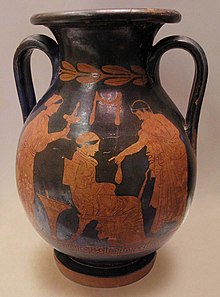Pelike

A pelike is a special form of the amphora , initially created in ancient Attic workshops , which was later also produced in other areas of Greece.
Unlike normal amphorae, peliks have a fixed base, which makes them very stable. Its widest diameter was in the lower half of the vessel. The jars had two vertical handles and no lids. As a rule, the transition between the neck and the bulky, compact body is fluid. The mouth was quite wide-walled. Peliken were first used at the end of the 6th century BC Created in the workshops of the so-called pioneer group of red-figure vase painting . The neck spelike is a rare special form of this clay jug. In this case, the neck is detached, i.e. not flowing, and the outline is generally less spherical.
Peliks were primarily used as wine vessels at symposiums and for storing oil. In addition, they could also be used to store other liquids or solid goods. From around 450 BC The pelike was also used to store the ashes in tombs. They were referred to as stamnos on pictorial inscriptions , but this term prevailed in modern archeology for a different vase shape .
Web links
literature
- Joseph Veach Noble: The Techniques of Painted Attic Pottery. Thames & Hudson, London 1988, ISBN 0-500-05047-3 , pp. 44 f.
- Andrew J. Clark, Maya Elston, Mary Louise Hart: Understanding Greek Vases. A Guide to Terms, Styles, and Techniques. J. Paul Getty Museum, Los Angeles 2002, ISBN 0-89236-599-4 , p. 127.